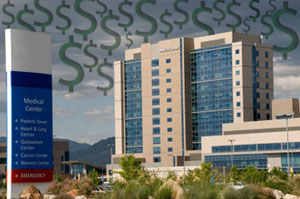After Congress’ fiscal cliff deal this week dug into hospitals’ pockets to avert a drop in Medicare payments to physicians, industry associations screamed. The president of the American Hospital Association said the reductions — nearly $15 billion over a decade — “will make it harder for patients to access the care they need.” The president of the Federation of American Hospitals also said patients would suffer because lawmakers had decided to “rob hospital Peter to pay for fiscal cliff Paul.”
Will hospitals be hobbled by Congress’ latest cuts? The answer may lie in a long-running dispute about whether Medicare has been overpaying hospitals for the past few years.
In late 2007, the Centers for Medicare & Medicaid Services (CMS) changed the way hospitals submit bills for Medicare patients. Its new system created 749 categories to allow hospitals to describe the illness level of their patients more specifically. The goal was to make sure that a hospital treating a person who has pneumonia and other illnesses, such as diabetes, for instance, would be paid more than a hospital treating an otherwise robust patient with pneumonia.
But the change raised a concern, said Paul Matsui, executive director of The Advisory Board Co., a Washington consulting firm. Medicare officials “knew right from the get-go there was going to be some incentive to put more codes on the claims, make sure you have all the different complications and” other illnesses, Matsui said. “They knew that was going to look like a rise” in the severity of the patients’ conditions, he said.
So Medicare proposed cutting its payment levels to counterbalance the likely change in billing. But the hospitals dissuaded the government from cutting rates, disputing the inevitability that coding would creep up.
After several years, CMS examined billing trends and determined that hospital patients suddenly were deemed sicker and warranted higher payments. The Medicare Payment Advisory Commission, or MedPAC, an independent agency that advises Congress, wrote in 2010 that the initial concerns about excess payments were correct and said the “improved coding increased payments by $6.9 billion over 2008 and 2009.”
Congress allowed Medicare to recover $6 billion of these overpayments through 2009, but last spring MedPAC estimated hospitals had received $11 billion in overpayments between 2010 and 2012, which Medicare was not empowered to get back.
The fiscal cliff legislation changed that, giving Medicare the power to recoup $10.5 billion of those overpayments over the next few years. The money will go toward putting off $30 billion in scheduled cuts in payments to doctors who treat Medicare patients.
Medicare pays hospitals about $117 billion a year, so the $11 billion reduction is substantial. Hospitals insist that they have not been overpaid and that the government never properly took into account the increasing sickness of their patients. “We have never agreed with the methodology that MedPAC and CMS have used to try to separate out real change from documentation and coding changes,” said Caroline Steinberg, a vice president at the American Hospital Association.
“All arrows point to Medicare patients getting sicker, and the idea that MedPAC and CMS have put forth in their calculations is that patients are getting less sick,” she said. She said Medicare “overdid it by about 35 percent” in its effort to claw back some of the payments.
Hospitals are also irked at the cuts because they come on top of $155 billion worth of reductions over 10 years that were part of the 2010 Affordable Care Act. The thinking was that since the law expanded the number of people with insurance, hospitals wouldn’t need as much help caring for those without coverage. But along with the adjustment for overcoding, Congress’ fiscal cliff deal also extended until 2022 the health law’s reductions in payments for hospitals that treat large numbers of uninsured and poor patients. The extended cuts will save $4.2 billion.
Atul Grover, the chief public policy officer for the Association of American Medical Colleges, said that while hospitals would have preferred not to face any cuts, the $10.5 billion cut Congress chose in the deal sealed on New Year’s Day was better than other options on the table. One of those proposals that hospitals lobbied against would have lowered Medicare’s payments for services delivered in hospital outpatient clinics to the same level as Medicare pays doctors for those services performed in their offices—something that would have hurt teaching and safety net hospitals the hardest.
“We don’t like our hospitals being used to pay our physicians, but at least the cuts they chose hit everybody,” Grover said.







